- Need Any Help: +1 647-760-5505 or
- info@trubicars.ca
In this module, we will explore the fundamental principles of vehicle braking systems, with a special focus on air brakes.
Stopping a vehicle involves converting its kinetic energy into heat energy through the braking system. This is a fundamental principle that applies to all types of brakes, including air brakes.
Understanding this concept is crucial for appreciating how different braking systems work, especially the air brakes used in large commercial vehicles.
When a vehicle is in motion, it possesses kinetic energy, which is the energy of movement. The primary function of a braking system is to convert this kinetic energy into heat energy, which is then dissipated into the environment. This conversion is what ultimately brings the vehicle to a stop.

Let’s break this process down further. Imagine driving a large truck down a highway. As you apply the brakes, the brake pads or shoes are forced against the brake drums or discs. This contact creates friction, and it’s this friction that converts the kinetic energy of your moving truck into heat energy. You might notice that the brakes can get quite hot after extensive use—this is because all that kinetic energy is being transformed into heat.
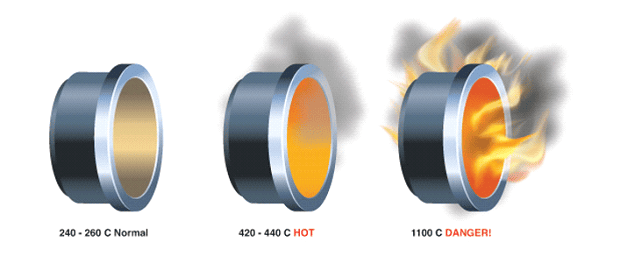
This principle of energy conversion is fundamental to all braking systems, whether they are air brakes, hydraulic brakes, or other types. However, the efficiency and effectiveness of this process can vary significantly between different systems. In large commercial vehicles, air brakes are often preferred due to their ability to handle the high energy loads involved.
Effective braking is not just about stopping the vehicle but doing so safely and reliably. This is particularly critical for large commercial vehicles, which have much more mass and therefore more kinetic energy that needs to be converted into heat. Poorly functioning brakes can lead to longer stopping distances, increased wear and tear, and, most importantly, a higher risk of collisions.
As we continue with this course, keep in mind this core concept of energy conversion. It’s the foundation upon which all braking systems are built. By the end of this module, you’ll have a deeper understanding of how air brakes utilize this principle to ensure safe and efficient stopping power for large vehicles.
Now that we’ve covered the basics of stopping a vehicle, we’ll move on to explore the differences between air brakes and hydraulic brakes. This will further enhance your understanding of why air brakes are the system of choice for many commercial vehicles.
In this slide, we will compare and contrast air brakes with hydraulic brakes. This comparison will help you understand why air brakes are commonly used in large commercial vehicles and how they differ from the hydraulic brakes typically found in passenger cars.
Let’s start with the basics. Air brakes and hydraulic brakes serve the same fundamental purpose: to slow down and stop a vehicle by converting kinetic energy into heat energy. However, the mechanisms they use to achieve this are quite different.
Air brakes operate using compressed air to apply braking force. When you press the brake pedal in a vehicle equipped with air brakes, you are actually controlling a valve that releases compressed air into the brake system. This air then pushes against the brake pads or shoes, creating the friction needed to stop the vehicle.
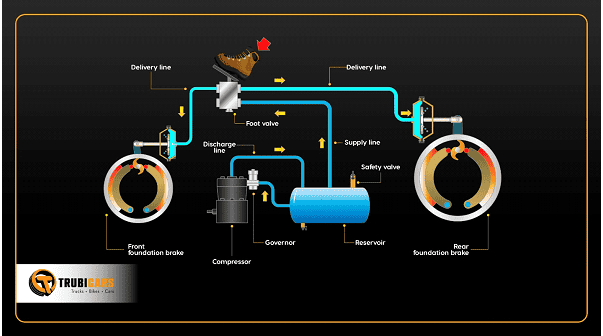
On the other hand, hydraulic brakes use a different method. In hydraulic brake systems, pressing the brake pedal forces brake fluid through a series of hoses and cylinders to the brakes at each wheel. This fluid transmission directly applies the braking force needed to stop the vehicle. Hydraulic brakes are highly responsive, with no noticeable delay in brake reaction, making them ideal for passenger vehicles.
One key characteristic of air brakes is the split-second delay in brake reaction. This delay occurs because it takes a moment for the compressed air to travel through the system and reach the brakes. This is a crucial point to understand, as it affects how drivers should anticipate and respond to braking situations in vehicles with air brakes.
To better visualize these differences, let’s look at some diagrams. On the left, you see a diagram of a hydraulic brake system. Notice how the brake fluid travels through the system to apply force to the brakes. On the right, you see an air brake system diagram. Here, the compressed air travels from the air reservoirs to the brakes, demonstrating the path air takes to apply braking force.
Now, let’s talk about the practical applications of these systems. Hydraulic brakes are widely used in passenger vehicles due to their quick response and efficient performance. However, they are not as effective for larger vehicles that require greater stopping power. This is where air brakes come in. Air brakes are designed to handle the higher loads and more demanding conditions of large commercial vehicles like trucks and buses. The ability to generate and maintain high braking force makes air brakes the preferred choice for these vehicles.
Understanding these differences is crucial for drivers and mechanics alike. Knowing that air brakes have a slight delay can help drivers better anticipate stopping distances and adjust their driving habits accordingly. Similarly, recognizing the components and operation of hydraulic brakes can aid in maintenance and troubleshooting.
In conclusion, while both air brakes and hydraulic brakes serve the same purpose, their mechanisms, response times, and applications differ significantly. Air brakes, with their ability to handle high loads and demanding conditions, are ideal for large commercial vehicles. Hydraulic brakes, with their immediate response, are perfect for passenger cars. As we move forward in this course, keep these differences in mind, as they will help you understand the specific characteristics and maintenance needs of air brake systems.
In this slide, we will begin our detailed exploration of the components that make up an air brake system. Understanding these components is essential for both maintaining and operating air brakes effectively.
Let’s start with the compressor, which is often considered the heart of the air brake system. The compressor is responsible for generating the compressed air needed to operate the brakes. It is typically driven by the vehicle’s engine and works continuously to ensure a sufficient supply of compressed air. The compressor takes in outside air, compresses it, and sends it to the air reservoirs for storage. Proper maintenance of the compressor is crucial, as it directly affects the performance and reliability of the entire brake system.
Next, we have the air reservoirs. These are storage tanks that hold the compressed air until it is needed for braking. Air reservoirs come in various sizes and configurations, depending on the vehicle’s requirements. They serve as a buffer, ensuring that there is always enough compressed air available to apply the brakes, even if the compressor temporarily stops working. This is important for maintaining consistent brake performance and safety.
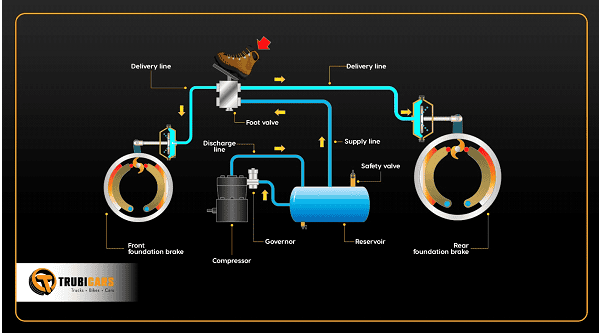
As you can see in the diagram, the compressor and air reservoirs are integral parts of the air brake system, working together to ensure a steady supply of compressed air. In the next slides, we will delve into the other key components of the system, including brake chambers, the foot valve, and brake shoes and drums/discs.
Continuing with our exploration of air brake components, let’s focus on the brake chambers and the foot valve. These components are crucial for converting the compressed air into the mechanical force needed to apply the brakes.
Brake chambers are mounted at each wheel and are responsible for converting the compressed air into mechanical force. When compressed air enters the brake chamber, it pushes against a diaphragm or piston, which in turn pushes a rod that applies the brake shoes against the brake drums or discs. This mechanical action creates the friction needed to slow down and stop the vehicle. Brake chambers come in various sizes and configurations, depending on the specific braking requirements of the vehicle.
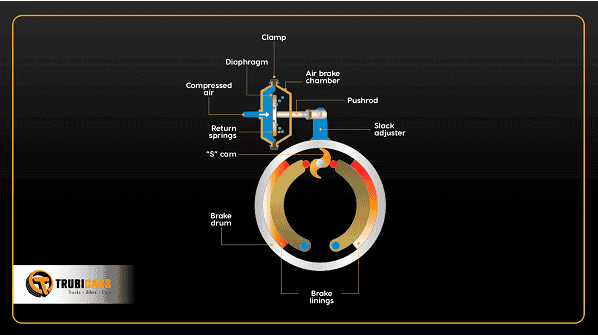
The foot valve, also known as the brake pedal valve, is the primary control valve used by the driver to regulate the air pressure sent to the brake chambers. When the driver presses the brake pedal, the foot valve opens, allowing compressed air to flow from the air reservoirs to the brake chambers. The amount of air pressure sent to the brake chambers is proportional to the force applied to the brake pedal. This allows the driver to control the braking force with precision.
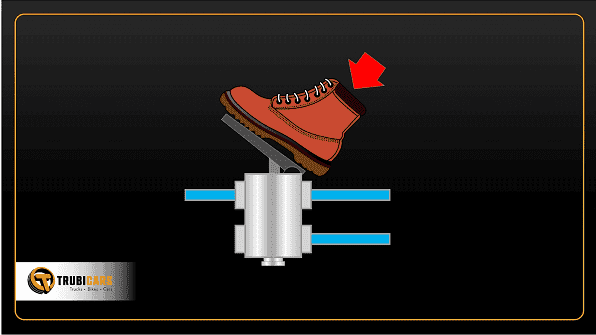
As illustrated, the brake chambers and foot valves work in tandem to ensure that the driver can effectively and safely apply the brakes. Understanding these components and their functions is essential for both operating and maintaining air brake systems. In the next slide, we will discuss the brake shoes and drums/discs, which are the final components in the braking process.
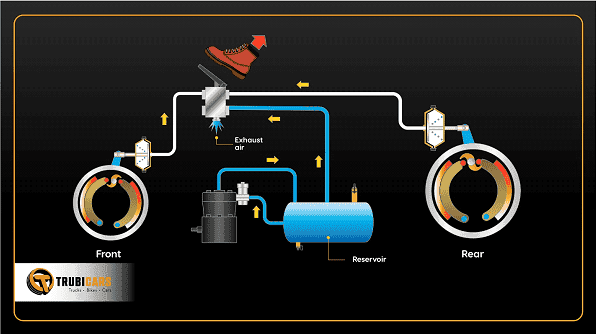
In the final part of our exploration of air brake components, we will focus on the brake shoes and drums/discs. These components are where the actual friction is generated to slow down and stop the vehicle.
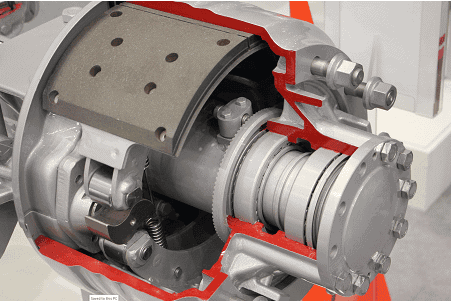
Brake shoes are typically found in drum brake systems. They are curved, metal pieces with friction material attached to their outer surface. When the brake chambers apply mechanical force, the brake shoes are pushed outward against the inner surface of the brake drums. This contact creates friction, which converts the vehicle’s kinetic energy into heat, thereby slowing down and stopping the vehicle.
Brake drums are cylindrical components that rotate with the vehicle’s wheels. The inner surface of the drum provides the contact area for the brake shoes. In disc brake systems, brake discs, or rotors, are used instead of drums. Brake discs are flat, circular components that also rotate with the wheels. In this system, brake pads, similar to brake shoes but designed for disc brakes, are used to create friction by squeezing the disc from both sides when the brakes are applied.
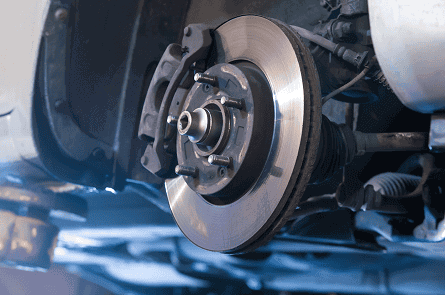
Both drum and disc brake systems have their advantages and applications. Drum brakes are often used on the rear axles of vehicles due to their durability and ability to handle high loads, while disc brakes are commonly used on the front axles for their superior stopping power and heat dissipation.
Understanding the role of brake shoes and drums/discs is essential for maintaining the efficiency and safety of air brake systems. By comprehending how these components work together to create friction and stop the vehicle, you will be better equipped to operate and maintain your vehicle’s braking system effectively.
In conclusion, the components of an air brake system – the compressor, air reservoirs, brake chambers, foot valve, and brake shoes and drums/discs – all work together to ensure that large commercial vehicles can stop safely and efficiently.
While air brakes are prevalent in large commercial vehicles, it’s important to understand the other types of braking systems that are commonly used in different types of vehicles.
Hydraulic brakes are the most common type of braking system used in passenger vehicles. They operate by using brake fluid to transmit force from the brake pedal to the brake components at each wheel. When the driver presses the brake pedal, the force is transferred through the brake fluid, which then applies pressure to the brake pads or shoes, creating the necessary friction to stop the vehicle. Hydraulic brakes are known for their quick response and reliable performance, making them ideal for everyday driving conditions.
These brakes are often used in trailers and electric vehicles. Electric brakes work by using an electric actuator to apply force to the brake components. In trailers, the brake controller sends an electrical signal to the brakes, which then applies the necessary force to slow down or stop the trailer. In electric vehicles, electric brakes are integrated into the vehicle’s braking system to enhance braking performance and efficiency.
Regenerative braking is a technology used in hybrid and electric vehicles to capture and reuse energy during braking. When the driver applies the brakes, the electric motor runs in reverse, acting as a generator to convert kinetic energy into electrical energy. This electrical energy is then stored in the vehicle’s battery for future use. Regenerative braking not only improves the vehicle’s energy efficiency but also reduces wear and tear on the brake components.
Understanding these various braking systems is crucial for recognizing their applications and benefits in different types of vehicles.